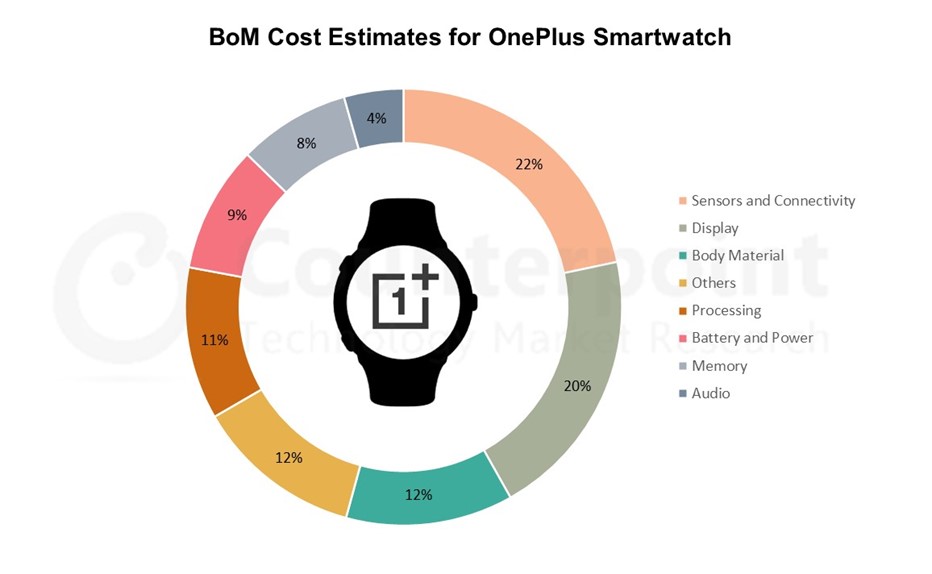OnePlus entered the smartwatch battlefield in March 2021 with the launch of the OnePlus Watch. The model features dual processing units that enable it to reduce battery consumption. According to Counterpoint Research’s bill of materials (BoM) analysis, producing the OnePlus Watch standard edition costs up to $68.
Sound selection of components from various manufacturers enables OnePlus to make a multifunctional smartwatch at an affordable price. The smartwatch has accelerometer, gyroscope, ambient light, air pressure, capacitance, and heart rate and blood oxygen (SpO2) sensors, which are commendable offerings in this price range.
Processor and MCU
OnePlus has assigned the smartwatch with a 32-bit Arm Cortex-M4 low-cost platform processor, STM32L4R9ZI6P, supplied by STMicro. The processor features a full set of DSP (digital signal processing) instructions along with 2MB of flash memory and 640KB of SRAM.
This is paired with the Apollo 3 Blue ultra-low-power microcontroller (MCU) from Ambiq Micro, which is an optimal solution for battery-powered devices and acts as the sensor hub. The MCU is based on the Cortex-M4F Core and supports a base clock frequency of 48 MHz which can clock up to 96 MHz and grants the smartwatch a balanced combination of performance and power efficiency. With a secondary MCU, the OnePlus Watch can continuously monitor and process the data collected from various sensors, even when the primary processor is at sleep or in standby mode.

Note: Numbers may not add up to 100% due to rounding off.
Storage and Connectivity
OnePlus has equipped the smartwatch with 1GB of RAM and 4GB of NAND flash. The eMMC NAND is manufactured by Kingston.
For wireless connectivity, the OnePlus Watch has two standalone chips correspondingly from Airoha and Infineon. The GNSS/GPS chip from Airoha integrates the RF and baseband circuits and can track multiple satellite constellations simultaneously, providing the user accurate location data and tracking with L1 and L5 dual-band support. Bluetooth 5.0 is enabled by the Infineon chip with an integrated 2.4 GHz transceiver, which is manufactured on a low power 40nm CMOS fabrication process.
OnePlus doesn’t offer connectivity features such as Wi-Fi or LTE. 30% of the BoM cost is occupied by storage, sensors and connectivity.
Display and Audio
The smartwatch has a sizable 1.39-inch AMOLED display with 2.5D curved glass that has a resolution of 454*454 pixels with a pixel density of ~326 ppi.
CS47L15 from Cirrus Logic, which is a high-performance, low-power audio codec that integrates an equalizer and programmable DSP with proprietary SmartHIFI technology, provides enhanced voice communication quality for both near-end and far-end users. The audio amplifier (AW8896CSR) is from Awinic. It supports bass and treble enhancement functions, enables High RF noise suppression and aids in audio quality enhancement.
Display and audio take up 24% of the BoM cost.
Body Structure and Battery
The OnePlus Watch has a well-built body that is constructed out of 316L (L – low amount of carbon) stainless steel, the preferred choice for smartwatch design as it is resistant to cracks and offers sound tensile strength.
Powering the smartwatch is a non-removable lithium-ion (Li-Ion) battery with a capacity of 402 mAh rated at 1.59 Wh. Power and battery management for the OnePlus Watch is handled by Texas Instruments PMIC Controller.
Conclusion
OnePlus has done a decent job on its first smartwatch offering. The selection of low-power and dependable components is great. But there is still a lot of room for improvement. Connectivity and storage are the two key areas where the OnePlus Watch is lagging immensely.























